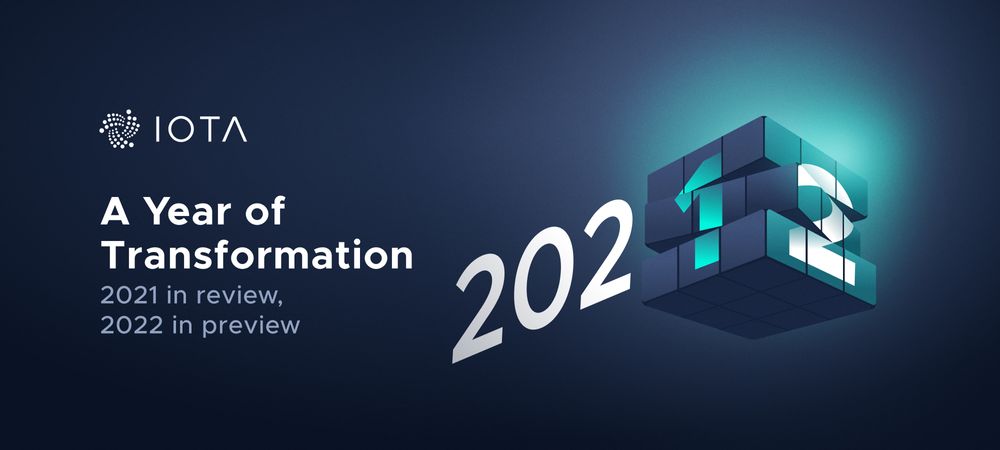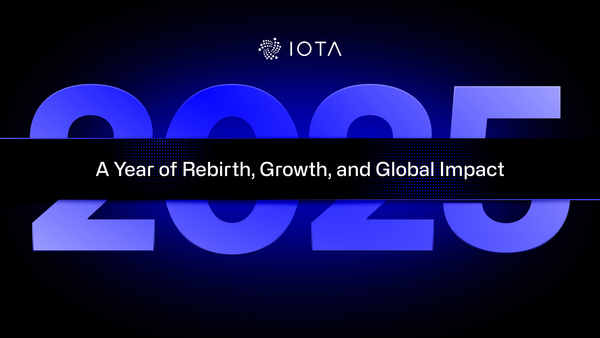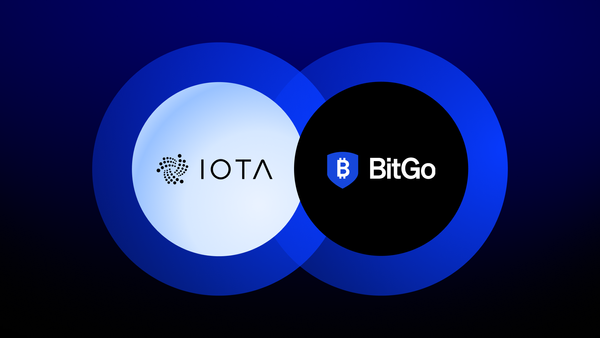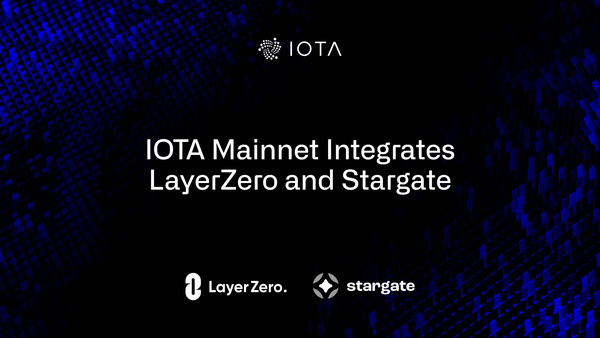A Year of Transformation
2021 in Review, 2022 in Preview
In 2021, IOTA underwent a radical transformation.
This year, the vision behind IOTA grew from being an infrastructure for the Internet of Things and the machine economy to being a foundational layer on which different networks and decentralized token economies can be built, secured and connected through the IOTA ledger. This vision sees IOTA becoming one of the most adopted ledgers not just in the industrial sector but in the crypto world. In the meantime, the IOTA Foundation grows from strength to strength, with over 180 team members comprising over 30 nationalities at the end of 2021 compared to 120 team members at the end of 2020.
The past year has proven that crypto is here to stay, with a tangible adoption happening across the crypto space, the popularity of NFTs, and the growth of DeFi applications, all driven by passionate developers who want to solve problems with technological innovation. After laying the groundwork in 2021, we will claim our place in this space in 2022.
Base layer: Ushering in a new era with Chrysalis
Setting the stage for the amazing developments in 2021 was the launch of the Chrysalis network upgrade in April this year. The most extensive upgrade in IOTA’s history, Chrysalis future-proofed the IOTA ledger, re-building IOTA from top to bottom and resulting in what is essentially a new protocol. It introduced several upgrades to the IOTA networks, including:
- A change of signature schemes, with Edwards-curve Digital Signature Algorithm (EdDSA) replacing Winternitz One-Time Signature Scheme.
- Major improvement in conflict handling due to a change from an account model to a UTXO model.
- A brand new Firefly wallet, published just ahead of Chrysalis to handle the IOTA token migration.
With these upgrades, Chrysalis is the launchpad for IOTA 2.0, a solid foundation for further innovations to be brought onto the mainnet in 2021 and 2022 – namely, staking, tokenization, and smart contracts. Chrysalis has set the stage for a programmable multi-asset ledger, able to host any kind of token (including NFTs) on the IOTA mainnet, and not just the native IOTA token. Thanks to Chrysalis, IOTA is a reliable network where transactions are confirmed in about 10 secs, where it's scalable, robust, and ready to be built on. As a sign of its success, over three billion dollars have migrated from the former legacy network to Chrysalis in less than 12 months since its inception.
The IOTA Digital Assets/ Tokenization frameworks
Introduced in February this year, and to be implemented on the mainnet in 2022, the IOTA Digital Assets framework is a major adoption driver, bringing tokenization – including NFTs – to the mainnet. A year in the making, with experimentation in the old Pollen network and DevNet and invaluable input from the Xteams, the IOTA Digital Assets framework enables the running of different applications on top of IOTA as a feeless base layer. As a Layer 1 framework, digital assets can be created by anyone, safe in the knowledge that their assets enjoy the same security and scalability as the native IOTA token.
With tokenization, real-world assets can be managed, traded, bought or sold on the Tangle, while the feeless nature of the protocol means that anyone can tokenize and utilize assets securely and cheaply. Tokenization enables everyone to build the future and have fun doing it.
A leap forward for IOTA Identity
In May, the IOTA Identity protocol, which is an implementation of decentralized digital identity, had its beta release. IOTA Identity is a Self-Sovereign Identity framework that enables people, organizations, or machines to create and have complete control over a digital identity – without the permission of an intermediary or central party. In addition, it gives control over how personal data is shared and used. Decentralized identity is a fundamental part of a digital economy, making this year’s progress on IOTA Identity a vital part of the following breakthroughs.
Watch the annual recap by the IOTA Foundation, IOTAshops.com, and EinfachIOTA
Staking: rewarding active participation in the ecosystem
In November, IOTA introduced staking to all IOTA token holders. Now, IOTA token holders can stake their tokens and earn staking rewards from token airdrops. By staking your IOTA tokens you are helping to launch new token economies and in return earn rewards from the newly minted tokens of upcoming networks and applications in the IOTA ecosystem – starting with the Shimmer network (see below).
Shimmer: IOTA’s testing playground
But how to safely upgrade the IOTA mainnet with these exciting but crucial updates? Enter Shimmer, publicly announced in November. Shimmer is an incentivized staging network with its own native token (SMR) where these upgrades are stress tested, tried, and developed (without the extended testing periods necessary on the mainnet) before being safely upgraded onto the IOTA mainnet. The launch of Shimmer in 2022 will be a huge boon for IOTA’s competitiveness and utility and accelerates IOTA on the path to full decentralization.
IOTA Smart Contracts: get ready to build
The IOTA Digital Assets framework also opened up smart contracts tokens on layer 2 – our third big breakthrough of 2021. One of the most impactful releases in 2021, the beta release of the IOTA Smart Contracts framework in October brought IOTA into the Web3 world, transforming IOTA from a protocol for frictionless transactions to a protocol with a programmable multi-asset ledger. Together with the integration of the Tokenization framework, IOTA Smart Contracts means that anyone can deploy their own nodes, join the smart contract network and deploy and interact with smart contracts. IOTA Smart Contracts enables unlimited use cases, making IOTA competitive in the market and utilized in the real world and the crypto world.
Assembly: completing the holy trinity
The latest ripple effect of the Chrysalis launch is Assembly. Building on IOTA Smart Contracts, Assembly is a permissionless multi-chain network to build, connect and deploy smart contracts. The protocol allows anyone to create their own sharded smart contract chain, with the flexibility to define their parameters, virtual machine, and validation requirements, and even customize fee and incentive structures. Every smart contract chain built on Assembly is a fully-sharded network, limited only by its own throughput while benefiting from the shared security and trustless interoperability of the global network. You can read the first of a four-part “Meet Assembly” blog post series here.
Together with IOTA and Shimmer, the arrival of Assembly completes the holy trinity to take on the crypto world and bring the benefits of decentralized IOTA tech to the mainstream. Read about the interconnections between each network here.
Partnerships and projects
Alongside the massive internal projects listed above, the IOTA Foundation also embarked on several important collaborations in security, smart cities, supply chains, and climate change measurement, as well as receiving important grants and continuing pre-existing partnerships (we don’t have space to list them all here – what follows is a list of highlights).
This year saw several major adoptions, tenders, and grants in the government and pan-European public sphere:
- In one of the year’s major adoption cases for IOTA – and a sign of how serious the EU is about blockchain – September saw the IOTA Foundation being selected by the European Commission to participate in the first two phases of the pre-commercial procurement process for the European Blockchain Services Infrastructure (EBSI), a network of blockchain nodes across Europe.
- In March, we joined some of Europe’s most influential blockchain and technology organizations in the CHAISE consortium, an EU-funded project to design a European strategy for developing blockchain and DLT skills training.
- In July, the IOTA Foundation publicized its grant-supported work on the future of transportation infrastructure as part of the EU-funded ORCHESTRA consortium, which innovates the future of multimodal transport. The foundation provides expertise for integrating its distributed ledger technology.
- The IOTA Tangle was selected as the core technology for SUSEE (Secure Sensor Platforms for Smart Energy Networks), a German government-funded research project that aims to design a scalable solution for reliable and secure data transmission and processing in sensor networks and to enable large-scale sensor networks.
- We joined Gaia-X, an initiative driven by leading enterprises, research institutions, and the European public sector that aims to enable the secure, open, and sovereign use of data in Europe and beyond. The IOTA Foundation contributes our DLT expertise, as well as the IOTA technology stack, to facilitate the development of Gaia-X core infrastructure and its application across different industry domains.
- We joined an international EU collaboration to support health organizations in the fight against cyber threats. SECANT (Security and Privacy Protection in Internet of Things Devices) is an EU-funded international collaboration between healthcare and security tech organizations; the IOTA Foundation will play a leading role in developing the project’s trust and accountability technology.
Another important focus area for IOTA adoption was global trade and supply chains:
- In July, we extended our partnership with TradeMark East Africa to facilitate paperless trade, cutting costs and delays in the supply chain while improving efficiency. Today we are testing the system with government agencies in Kenya, to be followed by a roll-out of testing in neighboring countries. Paperless trade with the Tangle aims to become a standard in 2022.
- In October, we announced that IOTA is being used in EPCIS 2.0, a global supply chain standard for storing and sharing supply chain event data (it is to supply chains what TCP/IP is to the Internet).
Other real-world industrial adoptions of IOTA technology included smart cities, digital identity, the construction sector, and more:
- The year kicked off with news about the international adoption of IOTA: a strategic agreement signed by the IOTA Foundation, the South Korean OBSR Foundation, and Tanglehub to jointly apply for smart city projects within South Korea and South East Asia. Read the announcement here.
- The post-Chrysalis possibility for the Tangle to be a reliable and production-ready base layer for a whole range of industrial partners was exemplified by IOTA’s partnership with Fetch.ai to offer autonomous economic agents on the Tangle. Based in Cambridge, England, Fetch.ai is an artificial intelligence lab that uses autonomous economic agents to process various information via AI-based applications for smart and innovative data solutions.
- We partnered with the UCL Construction Blockchain Consortium with a focus on IOTA DLT innovation in the construction sector and for smarter cities.
- IOTA’s Identity Services framework (specifically its Identity Actor) was put to the test in a collaboration with the Dutch bank de Volksbank, which presented a new Selv demo on how to set up a new business, a business bank account, and liability insurance using IOTA Identity for the sharing of reusable KYC credentials.
- Our last collaboration announcement of 2021 centered around smart cities and the construction industry, with more than $1.3 billion in real estate assets to be monitored using the IOTA Tangle by property operations monitoring company PropOps. PropOps allows for immutable audit trails, technical and infrastructural property management compliance, and rock-solid due diligence.
Alongside these new projects were several ongoing collaborations, just two of which we have space to highlight here. The ongoing coronavirus crisis gave added urgency to the continuation of our work with Zebra Technologies on (among other issues) the deployment of an open, secure, and interoperable infrastructure for vaccination certificate creation and verification. Our work with the H2020 ENSURESEC Project, an EU-funded innovation activity to strengthen the security of the e-commerce ecosystem, focused on safeguarding the digital single market e-commerce ecosystem by preventing cyber threats. Meanwhile, our partnership with ClimateCHECK (the Canada-based provider of climate and cleantech solutions) continues to address the climate crisis with the inclusion of IOTA Streams technology in a new state-of-the-art biodigester project in Chile, which will take place in 2022.
Looking ahead to 2022
As we embark on a new year, the top priority is to increase the utility of the IOTA token, network, and ecosystem.
Our early focus will be on bringing developments to the mainnet as fast as possible and ramping up education, training, development, and empowerment. We’re already seeing a range of NFT and metaverse projects being built on IOTA: you can find a few listed here.
In 2022, Shimmer will encourage the community to participate in the network and to grow and accelerate the adoption of new technologies. Assembly, meanwhile, will be the main driver of adoption for IOTA and the IOTA token.
Ultimately, our community has been the backbone of the year – launching applications (more than 24 are being built right now on IOTA), NFT projects and marketplaces, Digital Identity applications, and an entire DAO platform – and this is just the beginning.
To join us on the journey, follow IOTA on Twitter and Discord, Shimmer on Twitter and the #Shimmer channel on the IOTA Discord, and Assembly on Twitter and Discord.
Plus: Look back at our previous annual review posts for 2020 and 2019.
Follow us on our official channels for the latest updates:
Discord | Twitter | LinkedIn | Instagram | YouTube




